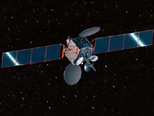
Ariane 5 is a retired European heavy-lift space launch vehicle developed and operated by Arianespace for the European Space Agency (ESA). It was launched from the Guiana Space Centre (CSG) in French Guiana. It was used to deliver payloads into geostationary transfer orbit (GTO), low Earth orbit (LEO) or further into space. The launch vehicle had a streak of 82 consecutive successful launches between 9 April 2003 and 12 December 2017. Since 2014, Ariane 6, a direct successor system, is in development.
The Helios 2 system, which consists of the Helios 2A and Helios 2B, is a French-developed military Earth observation satellite program. Financed at 90% by France, the development also involved minor participation from Belgium, Spain, Italy and Greece. Helios 2A was launched on 18 December 2004 by an Ariane 5 rocket from French Guiana.
Galaxy IV was a model HS-601 satellite built by Hughes Space and Communications Company (HSC). The satellite, which carried a payload of both C band and Ku band transponders, was launched on June 24, 1993 and operated by PanAmSat Corporation. It was in geostationary orbit at 99°W.

AsiaSat 3, previously known as HGS-1 and then PAS-22, was a geosynchronous communications satellite, which was salvaged from an unusable geosynchronous transfer orbit (GTO) by means of the Moon's gravity.
JSAT Corporation (JSAT) was the first private Japanese satellite operator, which owned the JSAT satellites, as well as operated and partially owned the N-Star with NTT DoCoMo. Its origins can be traced to the funding of Japan Communications Satellite Company (JCSAT) and Satellite Japan Corporation in 1985. Both companies merged into Japan Satellite Systems Inc. in 1993. In 2000 the company was renamed as JSAT Corporation and was listed in the First Section of the Tokyo Stock Exchange. On September 1, 2008, the company was merged into the SKY Perfect JSAT Group.
Intelsat 2, formerly PAS-2, was a communications satellite operated by Intelsat which spent most of its operational life serving the Pacific Rim market from a longitude of 169° East. Launched in July 1994, the satellite was operated by PanAmSat until it merged with Intelsat in 2006. The spacecraft was renamed, along with the rest of PanAmSat's fleet, on 1 February 2007.
Intelsat 3R is a communications satellite owned by Intelsat located at 43° West longitude, serving the Americas market.
Horizons Satellite is a joint venture between Intelsat and SKY Perfect JSAT Group. Originally formed in 2001, pursuant to a memorandum of understanding between JSAT Corporation and PanAmSat for the launch of Horizons-1, it was renewed for Horizons-2. JSAT later merged into the SKY Perfect JSAT Group and PanAmSat was acquired by Intelsat, but the companies continued with the relationship, with the order for Horizons-3e. Both companies also launched a joint satellite, Intelsat 15/JCSAT-85, but instead of the equal share agreement of this joint venture, JSAT owns a specific payload of 5 transponders out of the 22 Ku band transponders of the spacecraft.
The DirecTV satellite fleet is a group of communications satellites located at various geostationary orbits that DirecTV uses for their satellite television service and HughesNet internet service. The "DirecTV" prefix in their names has been changed to "T".
Intelsat 5 was a satellite providing television and communication services for Intelsat, which it was commissioned by in 2006.

SES-14 is a geostationary communications satellite operated by SES at 47.5° West, replaces NSS-806, and designed and manufactured by Airbus Defence and Space. The satellite launched on 25 January 2018 at 22:20 UTC along with the Global-scale Observations of the Limb and Disk (GOLD) instrument from NASA. It has a mass of 4,423 kg (9,751 lb) and has a design life of at least 15 years.
BSAT-2b, was a geostationary communications satellite ordered by B-SAT which was designed and manufactured by Orbital Sciences Corporation on the STAR-1 platform. It was designed to be stationed on the 110° East orbital slot along its companion BSAT-2a where it would provide redundant high definition direct television broadcasting across Japan.
BSAT-3c, also known as JCSAT-110R, is a geostationary communications satellite operated by Broadcasting Satellite System Corporation (B-SAT) and SKY Perfect JSAT (JSAT) which was designed and manufactured by Lockheed Martin on the A2100 platform.
The JSAT constellation is a communication and broadcasting satellite constellation formerly operated by JSAT Corporation and currently by SKY Perfect JSAT Group. It has become the most important commercial constellation in Japan, and fifth in the world. It has practically amalgamated all private satellite operators in Japan, with only B-SAT left as a local competitor.
NSS-806, before Intelsat 806, is a communications satellite originally operated by Intelsat. Launched in 1998 it was operated in geostationary orbit at a longitude of 47 degrees west for around 15 years. It is currently located in the orbital position of 47.5 degrees west longitude, was initially operated by Intelsat, orbited at 40.5 degrees west, and was purchased by SES World Skies.

Ariane flight VA241 was an Ariane 5 space launch that occurred from the Guiana Space Centre on 25 January 2018 at 22:20 UTC.
Intelsat 7, formerly PAS-7, was a communications satellite operated by Intelsat which spent most of its operational life serving the Europe, Africa, Middle East, Asia market from a longitude of 18° West.
PAS-3, was a communications satellite for PanAmSat. Launched in December 1994.



